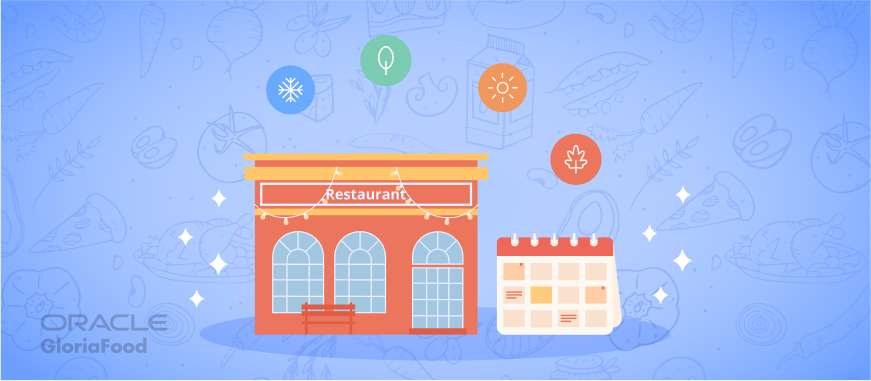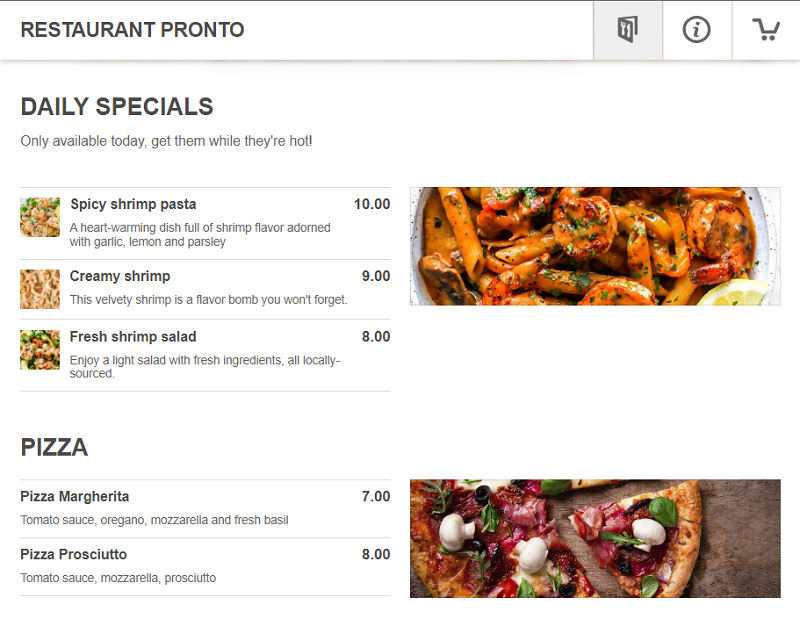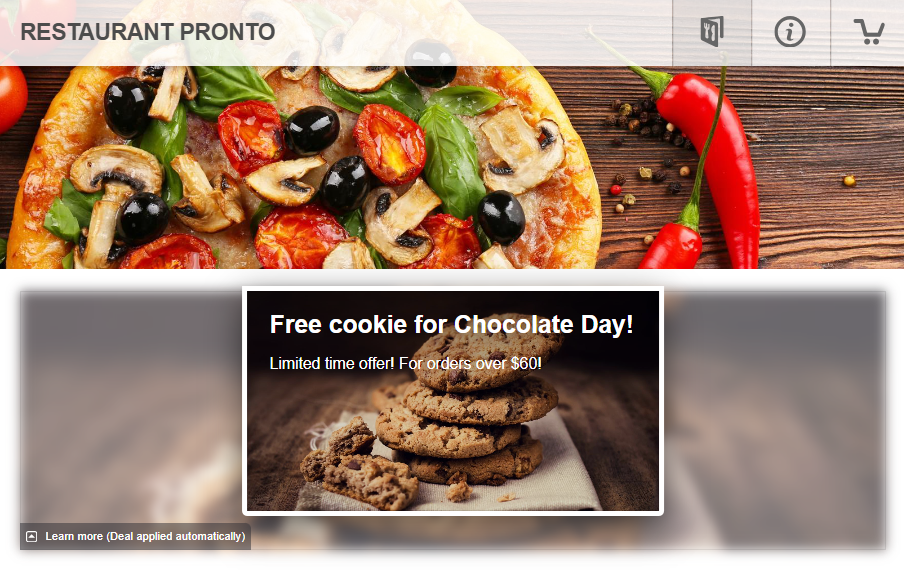- 1.What is the Seasonality of Restaurants?
- 2.What is Food Seasonality?
- 3.5 Seasonal Factors Affecting the Restaurant Industry
- 4.What Are the Slowest Months for Restaurants?
- 5.What Is the Busiest Month for Restaurants?
- 6.How to Use Restaurant Seasonality to Your Advantage: 6 Tips & Tricks
- Start delivering your food to reach customers anywhere, anytime
- Create a seasonal menu based on fresh, local ingredients
- Ensure customers are comfortable no matter the weather
- Capitalize on holidays to get ahead of the competition
- Schedule the right amount of employees
- 7.Final Words
Restaurant seasonality can be daunting for many restaurant owners. We’re here to tell you that you can use it to your advantage instead of running away from it. Capitalize on seasonal ingredients, tourism, and holidays to attract more people to your restaurant and boost sales.
What is the Seasonality of Restaurants?
In the restaurant industry, seasonality refers to the fluctuations in demand that restaurants experience depending on the season. For example, summers are usually more profitable due to a larger number of customers wanting to go out and enjoy the nice weather.
What is Food Seasonality?
Complementary to restaurant seasonality, food seasonality refers to purchasing and using produce around the time of the year when it is naturally harvested. That’s when the flavor is most intense and the quality the best.
What are the benefits of seasonal food?
For customers, the food is tastier, fresher, and more nutritious. It also contains fewer preservatives, waxes, or pesticides because you don’t need to preserve it for as long.
For restaurants, serving seasonal food can:
- Lower food costs;
- Minimize waste;
- Help you support local producers;
- Attract new customers, thus boosting profits;
- Make your restaurant more environmentally friendly.
Why is eating seasonal food good for the planet?
Buying, selling, and consuming seasonal produce helps reduce carbon emissions by decreasing the amount of time between when the food is harvested and when it gets consumed.
This and other restaurant sustainability practices can help you market your restaurant to the increasingly “green” consumer.
5 Seasonal Factors Affecting the Restaurant Industry
All the factors below influence customer preferences regarding food and the economic standing of food businesses. Read on to learn how to mitigate these factors and what to do when restaurant business is slow:
- Weather: Perhaps one of the most common factors affecting sales in a restaurant is the weather. When it’s warm out, customers love spending time at their favorite restaurants, especially if they have a terrace. When faced with a blizzard, no one wants to go out and they prefer to order instead.
- Ingredients: Ingredient availability also affects restaurant seasonality. If you have a year-round menu that relies on very specific ingredients, you might miss out on sales by having out-of-stock dishes or lowering food quality by using out-of-season ingredients. Consider having a small menu that changes every season.
- Location: Where your restaurant is located in the world also matters. If you’re in Russia, winter might be tough for you, while a restaurant in Spain might not feel a difference in winter sales.
- Holidays: Every season has its important holidays when people usually prefer to stay at home with their families. This can affect your business if you don’t focus on restaurant holiday marketing.
- Tourism: While tourism usually increases in the summer, which is one of the reasons restaurants thrive in the warm season, it also depends on where your restaurant is located. If it’s in a popular tourist hot spot, focus on collecting reviews because tourists will look on platforms like Yelp before they visit a restaurant.
What Are the Slowest Months for Restaurants?
Typically, the slowest months for restaurants are January and February, right after the holidays. Naturally, that is not a blueprint for all restaurants across the world, but in general, winter months are slower.
To identify the slowest restaurant months of the year, use a restaurant data analytics tool to monitor your sales throughout the year. For example, the Reports module from GloriaFood is free, easy to use, and gives you access to valuable data that will help you increase your sales.
What Is the Busiest Month for Restaurants?
When are restaurants most busy? Once the weather gets better, starting with April, restaurants witness a boost in sales, all the way to November. Some restaurants are also pretty busy in December.
According to 2022 quick-service restaurant sales by month, July, August, May, June, and October are followed by December with the most sales.
How to Use Restaurant Seasonality to Your Advantage: 6 Tips & Tricks
Check out these restaurant sales building ideas that will help you increase your profit, no matter the season:
Start delivering your food to reach customers anywhere, anytime
Instead of trying to attract customers to your restaurant when all they want to do is hang out at home, take your food to them by enabling delivery.
With the GloriaFood online ordering system, the process only takes 10 minutes. Check out this video for a step-by-step tutorial:
Create a seasonal menu based on fresh, local ingredients
Your menu should change with the seasons to maintain your customers’ interest over time. Show them there’s not one dull moment at your restaurant with daily specials and limited-time offers.
And don’t worry about having to update your menu following restaurant seasonality. With our system, you can make changes on the fly and publish them in real-time anywhere your online menu is displayed.
Here’s how easy it is to create the menu of your dreams in minutes:
You can also use the same menu for dine-in ordering and allow customers to order and pay at the table by scanning a QR code.
Watch the tutorial below to learn how to create a QR code menu from scratch:
Ensure customers are comfortable no matter the weather
Living in a cold area in winter will inevitably affect your restaurant sales. However, there are things you can do to prevent or minimize those effects.
How to make a slow restaurant busy? Your main goal should be to encourage customers to visit your restaurant despite the weather. So, promise the trip will be worth it.
In the summer:
- make sure you have AC inside;
- A shaded terrace where customers can take cover from the sun;
- Offer a free ice creamor a cold drink to everyone brave enough to brace the heat and pay you a visit, and you’ll be the talk of the town.
During the colder months:
- Place heaters on the terrace;
- Welcome your customers with cozy winter drinks and dishes that will warm their hands and their hearts. That’s how you do restaurant seasonality right!
Capitalize on holidays to get ahead of the competition
Restaurants that aren’t open on major holidays and special events are missing out on the opportunity to target customers who prefer to spend their time with the family instead of cooking.
You don’t have to necessarily keep your restaurant open on holidays. However, if you do, encourage people to book a table to make sure they’re not left outside in the cold waiting for an opening.
Taking advantage of the main holidays is great, but celebrating every occasion is better. You can fill your tables by creating special promotions for World Burger Day or offering a small free dessert for Chocolate Day.
Check out this restaurant marketing calendar that will help you prepare for the whole year:
Restaurant Marketing Calendar: How to Successfully Prepare for 2025
Make your restaurant more tourist-friendly
To ensure you are not left behind when tourists visit your area, strive to make them feel welcome:
- Hire staff that speaks English to break through the language barrier;
- Offer combo deals for families that travel together;
- Display your menu in English outside the restaurant to attract tourists’ attention;
- Offer complimentary water on hot days to help people stay hydrated;
- Install universal sockets and WiFi to serve as a space where tourists can take a breather.
To make your restaurant more visible for tourists who look for places online, ensure your website is optimized with the keywords you’re targeting (e.g., Italian food in Scranton, Pennsylvania). This will signal to Google that your website is relevant for people’s searches.
If you want to learn how to get a restaurant website that’s already optimized for search engines and sales, watch the video below:
Something else you can do to increase your restaurant’s online visibility is claim and fill in your Google Business Profile, which displays valuable information about your restaurant directly in the search engine.
Schedule the right amount of employees
When you are trying to tackle the busiest months for restaurants, you will need more servers to handle the rush. On the opposite, during the slow months, you don’t need as many employees on the floor to serve clients.
Labor costs are one of your biggest expenses and the only way to lower them is to schedule the perfect number of employees for each day. Your goal should be to find the minimum number of workers necessary to guarantee client satisfaction.
Here is how you can do it:
- Use data from the previous year to forecast how full your restaurant will be;
- Use a POS with built-in staff management software, like the efficient one from GloriaFood to make it easier to offer the same hours to all employees, without leaving a day uncovered;
- Take the toll off your employees by leveraging technology. For example, by enabling the on-premise dining feature from GloriaFood, clients can order, browse the menu, and pay, by just scanning a QR code on their table. This way, your servers will have time to focus on more important tasks.
Final Words
If you’ve always been wondering what to do when the restaurant business is slow due to seasonal changes, this guide can serve as a blueprint. The good news is you can learn how to capitalize on restaurant seasonality instead of fearing it and make the weather work for you.



